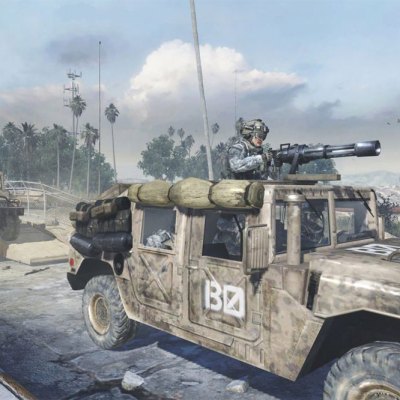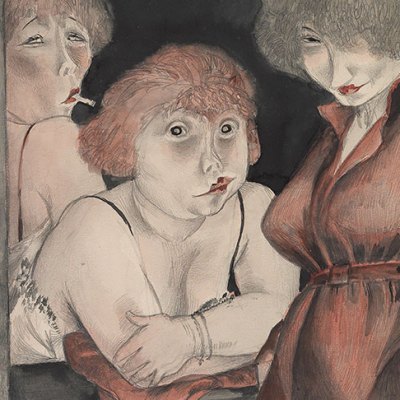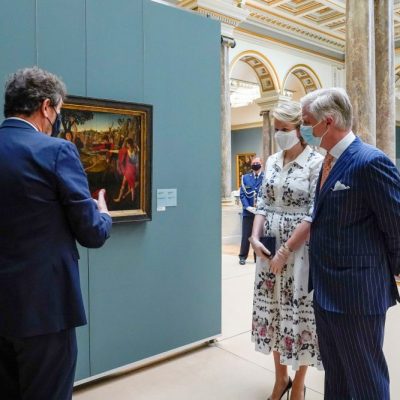This article was originally published the March 2020 issue of Apollo, before museums in the Netherlands were closed due to the Covid-19 pandemic. Museum MORE reopens on 1 June.
Ruurlo Castle in the east of the Netherlands, with its moat, maze and 16th-century turrets and stepped gables, looks straight out of a fairy tale. It is something of a shock to find out that during the Second World War it served as the headquarters of SS commander Heinz Harmel. Since 2017, under the patronage of Hans Melchers, the Dutch billionaire who fished in the castle grounds as a boy and ever since dreamt of owning it, it has been a branch of the Museum for Modern Realism (Museum MORE). The architect Hans van Heeswijk built a new steel-and-glass access bridge and it is now home to the world’s largest collection of paintings by the Dutch magic realist Carel Willink (1900–83) – Melchers’ gift to the Achterhoek region in which he grew up and still lives.
Hans Melchers’ father was painted by Willink, who was a popular society portraitist in the interbellum, one of the most sought after and expensive in the Netherlands. The family lived in Arnhem, the provincial capital that was badly bombed during the war, and the picture was lost, presumed destroyed or looted. Melchers collected a few other canvases by Willink, almost as a reparative act, including an image of two figures in a pastoral landscape beneath a mountain peak, one of whom clutches the other by the throat with an outstretched arm, as his victim writhes in agony – a scene that Melchers apparently likes to joke resembles himself in the clutches of the taxman.
Ruurlo Castle, the Netherlands, a branch of Museum MORE since 2017 and home to the largest collection of paintings by the Dutch artist Carel Willink. Photo: Rutger Hollander
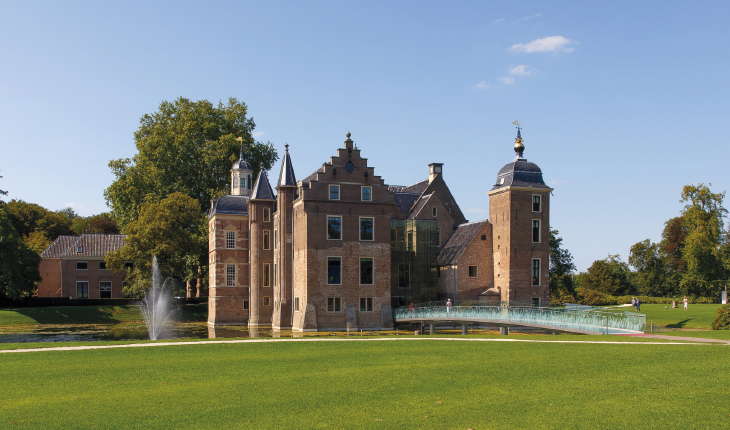
In 2012, Melchers acquired much of the art collection of Dirk Scheringa, the bankrupt owner of DSB Bank: 484 works by Dutch artists from the first half of the 20th century, including 31 paintings and 104 works on paper by Willink that Melchers feared would otherwise be lost to the nation. He originally imagined that Ruurlo Castle would make a museum for the whole collection, which would be displayed on rotation, but soon began scouting the area for a larger, more suitable home. In 2015 he founded the first branch of Museum MORE in nearby Gorssel, in a building also designed by Hans van Heeswijk.
Willink’s neorealist paintings are known for their sense of alienation and foreboding, ominous landscapes with classical architecture and statuary, shown under moody skies that create strange light effects and cast long shadows. Almost 50 of Willink’s canvases are on show at Ruurlo, beginning with an unfinished self-portrait he made at the age of 18, when he was training to be an architect; the museum charts his progress from youthful experimentation with Expressionism and cubism to the technical sheen of his enigmatic masterpieces, which reveal the influence of Giorgio de Chirico and his reading of Oswald Spengler’s The Decline of the West.
These monumental paintings, also informed by Willink’s study of Holbein, Vermeer and Antonis Mor, are shown against walls covered in colourful damask silk by the Dutch couturier Ronald Kolk, which reflect and draw out their apocalyptic, agitated energy. The Tate Gallery Moved (1970) shows Tate Britain in a lunar landscape, its soil marked with tracks that are the only sign of life; in the foreground is a cave of human remains. Landscape with Nuclear Power Station (1982) shows monstrous, crumbling caryatids from the 16th-century gardens of Bomarzo in front of the cooling towers of Three Mile Island near Harrisburg, Pennsylvania, which closed following a radioactive meltdown in the late 1970s. Exotic animals such as llamas or zebras often provide disquieting, surrealistic flourishes. Willink described his style as ‘imaginary’ or ‘fantastic realism’ and himself as an ‘amused pessimist’. ‘At the core of my work,’ he said, ‘is a fatal infatuation with reality.’
Landscape with Nuclear Power Plant (1982), Carel Willink. Museum MORE, Gelderland. © Sylvia Willink-Pictoright Amsterdam 2020

On the upper floor of the castle is Willink’s Farewell Mathilde (1975), which depicts the artist’s third wife and eccentric muse, Mathilde de Doelder, on the brink of their divorce. Opposite is a photograph of him painting her and a vitrine containing the cloak dress that she is wearing, a glam-rock gold and silver leather construction decorated with a stalking leopard. It was created by the Chinese-Dutch designer Fong Leng and half a dozen other extravagant outfits by Leng, who has also made stage costumes for Kate Bush, are on display in an adjoining room. Mathilde, the Lady Gaga of the 1970s, wears her hair in milkmaid braids and her make-up, as painted by Willink, borders on that of a pantomime dame.
Willink met Mathilde when she was a stewardess for KLM in her early twenties and he was 60. He called her his ‘superpussycat’ and, while they were together, she became a fashion icon and media phenomenon, an extravagant party animal well-known on the Amsterdam scene. The artist found new fame through her, and under her influence became increasingly flamboyant and Dalíesque. However, in 1975 he left her for an even younger woman, the sculptor Sylvia Quiël, who became his fourth wife. In 1977, having taken up with her drug dealer, Mathilde was found dead in her bed, in mysterious circumstances; it was announced a suicide, but many suspected she had been murdered.
Portrait of Lotte Radermacher-Schorer (1939–40), Charley Toorop. Museum MORE, Gelderland. © Pictoright Amsterdam 2020
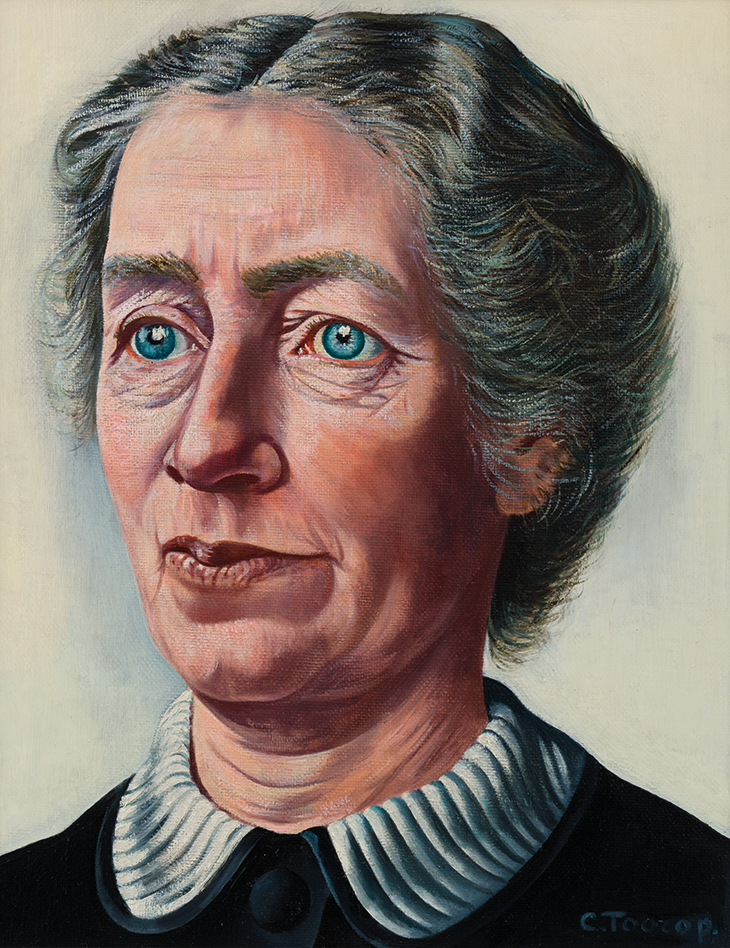
Among the paintings Melchers bought from Dirk Scheringa were other artists that Ype Koopmans, creative director of Museum MORE, calls the ‘big five’: as well as Willink, this art safari consists of Pyke Koch, Raoul Hynckes, Wim Schuhmacher and Dick Ket. Other well-represented artists include Charley Toorop and Jan Mankes. They were all largely self-taught and avid disciples of Max Doerner’s study of Old Master techniques, The Materials of the Artist and Their Use in Painting (1921), which they sought to apply to a new era. For example, they revived tempera painting, mixing pigment with egg yolks to produce a brushless finish, a technique that required great expertise and patience – many of their canvases took years to make.
Before the Second World War, realism was the most important genre of painting in the Netherlands, but after the war it was, Koopmans says, ‘consciously forgotten’, as it was all over the world, tainted as it was by that era. From 1934 until 1941, Pyke Koch was a member of a fascist party (in 1934, he joined the Verdinaso, which was absorbed into the National Socialist Party of the the Netherlands in 1940), and other artists – such as the communist Wim Schuhmacher – didn’t want to be shown in an exhibition with him, though both ends of the political spectrum painted in very similar styles. With the post-war rise of CoBrA, which eschewed naturalism and instead sought to release the artist’s inner child, and with the popularity of minimalist art in the 1960s, realism came to be seen as hopelessly old-fashioned.
Fountain in Corte, Corsica (1928), Wim Schuhmacher. Museum MORE, Gelderland. © Estate of Wim Schuhmacher

However, in Holland there was a revival of interest at the end of the 1970s, cemented by the Pompidou’s influential exhibition from 1980, ‘Realism – Between Revolution and Reaction 1910–1939’. Old collectors of realism were dying, and work was coming on to the market at relatively low prices. Melchers has contributed substantially to this reappraisal. ‘It started with one man’s vision,’ Koopmans says of Museum MORE. ‘Then came a creative director, curators, guest curators. The museum is now the vision of a group of art historians emerging since the 1970s who did a lot of research on this kind of art.’
Behind Gorssel’s former town hall, which was built in 1914 and now houses a cafe and auditorium, Van Heeswijk has added four staggered wings clad in French limestone, which contain seven galleries over two floors. Known among his peers as ‘Mr Museum’, the architect has built a new entrance to the Van Gogh Museum in Amsterdam, and adapted and extended the Hermitage Amsterdam, as well as the Mauritshuis in The Hague. But Museum MORE is his first purpose-built museum. A large skylight runs along the foyer, designed to frame the kind of moody atmospheres that enchanted Willink, and all the galleries have picture windows or other vistas, designed so that visitors can easily orient themselves. An hour and a half’s drive from Amsterdam, the museum and castle together attracted 240,000 visitors last year.
Koopmans wanted the collection to continue to connect the present with history, and deliberately avoided a chronological hang. A painting from 1953 by Pyke Koch, showing a diver somersaulting above a wooden fence that surrounds a rural swimming pool, is contrasted by a painting from 1980 by Hermanus Berserik of a weaver’s loom, which shows a bobbin of wool hanging in space above a textile whose pattern echoes the painted fence in Koch’s canvas. A painting from 1934 by Willink of an abandoned neoclassical cityscape is placed next to one by Schuhmacher of a deserted public square in Corsica dated 1928. A picture of a train by Frans Stuurman, dated 2007, is shown next to a 1950s painting of an ocean liner coming into port by Jan Ouwersloot that the museum purchased recently for a mere £200 on the online auction site Catawiki.
Village Swimming Pool I (1953), Pyke Koch. Museum MORE, Gelderland. © Estate of Pyke Koch
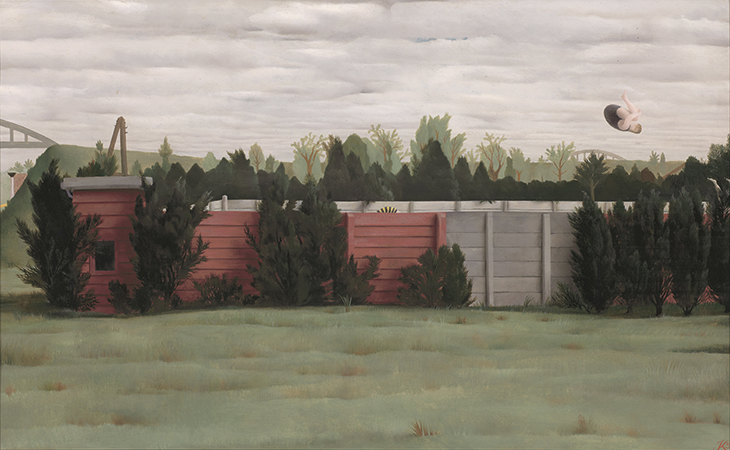
Koopmans continues to acquire Dutch ‘realism’, a notoriously vague and slippery term, but he is ‘very selective with contemporary work – it has to connect with the rest of the collection’, which he characterises as ‘gloomy, surrealistic, in between new objectivity and magic realism’. Realism has, since the 17th century, been a particularly Dutch affair, but the museum wants to show that such hard-edged naturalism is a story that changes all the time, and is still alive. A painting from 1968 by Rein Draijer of an easel against a blank canvas, which verges on the abstract, seems to both point to the death of painting and the resilience of realism. For Museum MORE realism is an elastic, kaleidoscopic concept that takes on almost existential import – less Courbet’s peasant grittiness and more a magic realism that seeks to tell truths by showing alternate universes. The galleries devoted to the permanent collection begin with a quotation by Bertolt Brecht: ‘Realism is not how real things are, but how things really are.’
You enter the museum through a room hung with only contemporary work. There are Erwin Olaf’s photographs, shot in studios or locations that are dressed like film sets, such as Victoria (2007), from the Grief series and apparently inspired by the widowed Jackie Kennedy. A young woman is shown in profile, clutching a handbag in a Hopperesque hotel interior. ‘American glamour, combined with sadness,’ Koopmans comments. ‘The same kind of atmosphere as Willink.’ Arnout Killian’s Cubicles (2011), a large-scale canvas depicting an office arranged like a battery farm, creates a new, premonitory reality out of an image found on the internet. Lotta de Beus’s Truth or Dare (2008) uses 16mm film as its source material to create a sfumato effect that hints at the slightest movement. Other paintings by Mark Outjers and Lara de Moor quote and riff on Vermeer. ‘Always emptiness and stillness,’ Koopmans muses.
The upper floors of Museum MORE are devoted to exhibitions intended to examine the international context of Dutch realism. When I visit in January, ‘For Real: British Realists in the 1920s and 1930s’ is on view, featuring 75 works by 35 artists and involving loans from the National Portrait Gallery, Royal Academy of Art, Ashmolean, Tate, and numerous private collections. (The show was an adaptation of the 2017 exhibition ‘True to Life’, which Koopmans saw at the Scottish National Gallery of Modern Art in Edinburgh.) During the interwar period, British critics and art theorists took pride in their country’s ‘splendid isolation’ and warned against the contamination of the German ‘Neue Sachlichkeit’, but the exhibition makes clear that British artists were influenced by Dutch realism and vice versa. Stanley Spencer, Koopmans points out, was collected by the Stedelijk Museum as early as 1937, making it the first institution outside of England to do so. His self-portrait from 1936, in which he looks at himself with a direct gaze and sinewed intensity, is reminiscent of Dutch contemporaries such as Dick Ket, an artist well-represented at MORE. More broadly, Koopmans found it hard to detect much angst in British painting of this time. ‘The uncertainties and fears of the 1930s are sometimes clearly present in the works of our Dutch artists,’ he says, ‘but the British seem less afraid of an unpredictable future. Theirs is sooner a sense of melancholic yearning for a sheltered and private paradise.’
Street with Statue (1934), Carel Willink. Museum MORE, Gelderland. © Sylvia Willink-Pictoright Amsterdam 2020
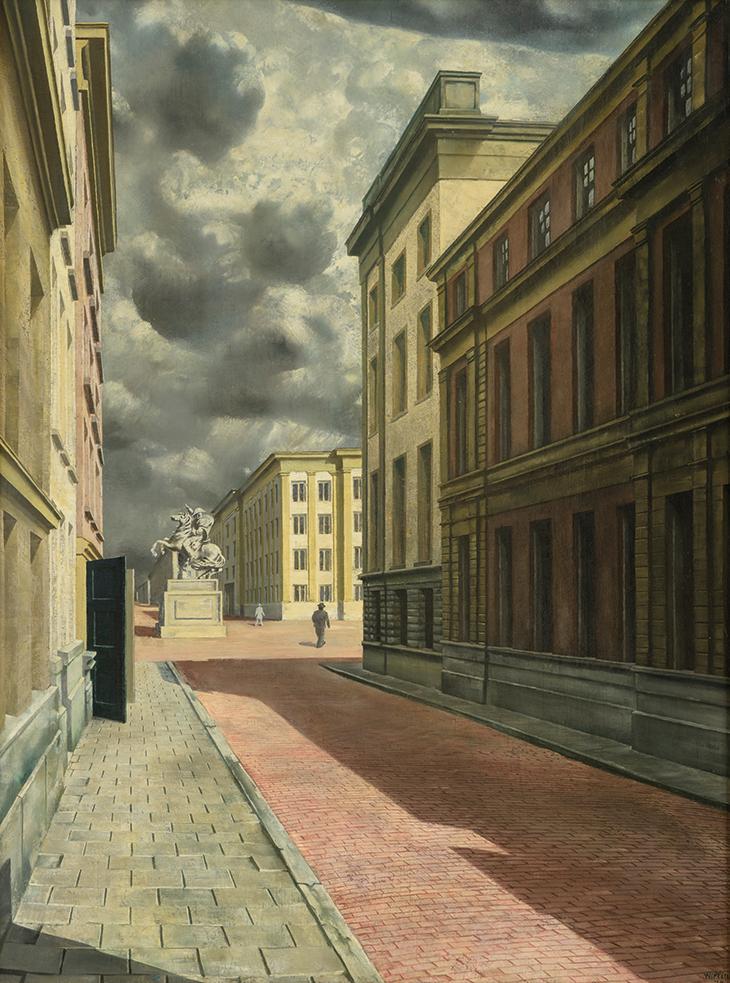
An exhibition in the autumn will be devoted to the work of Bob Ross, the American TV art instructor and star of The Joy of Painting, who resembled Rolf Harris with an afro-like perm. Between 1983 and 1994, he made 31 popular series, each containing 13 programmes, in which he completed a painting in half an hour using the wet-on-wet (alla prima) technique of Rembrandt and Frans Hals. These kitsch works, for which Ross provided an amiable voiceover, feature pointy pines in sherbet mountains, frothy waterfalls and lacquered lakes (but never people), warmed by a golden light. Ross did three versions of each canvas (one before, during and after transmission), but refused to sell a painting, and the MORE exhibition presents 40 canvases from the 30,000 or so that Bob Ross Inc. holds in storage.
The museum does not have a board, or an acquisitions committee and operates independently of government, which gives Koopmans enviable freedom, especially when making acquisitions. ‘Yesterday I heard about a nice Schuhmacher up for auction in Dallas […] and then we bought it,’ he says. Schuhmacher was the ‘master of grey’ who worked a lot in Italy and France, and the painting depicts an elderly Italian lady in a landscape that has an appropriately eerie feel. This agility, Koopmans qualifies, ‘depends on Mr Melchers, of course, and his spirit of the day’. Nevertheless, Melchers sounds a hands-off boss, giving Koopmans much latitude: ‘the castle is more of his domain,’ Koopmans says. Willink is the touchstone. ‘Willink is his favourite painter,’ Koopmans adds. ‘Everything is measured on Willink: his taste always remembers Willink.’
From the March 2020 issue of Apollo. Preview the current issue and subscribe here.
Correction: an earlier version of this article claimed that Pyke Koch was a fascist ‘for a short time’ and that he left the party in 1940. This has been corrected to reflect the fact that Koch was a member of a fascist party for seven years, and that he left the National Socialist Party of the Netherlands (the NSB) in 1941.
